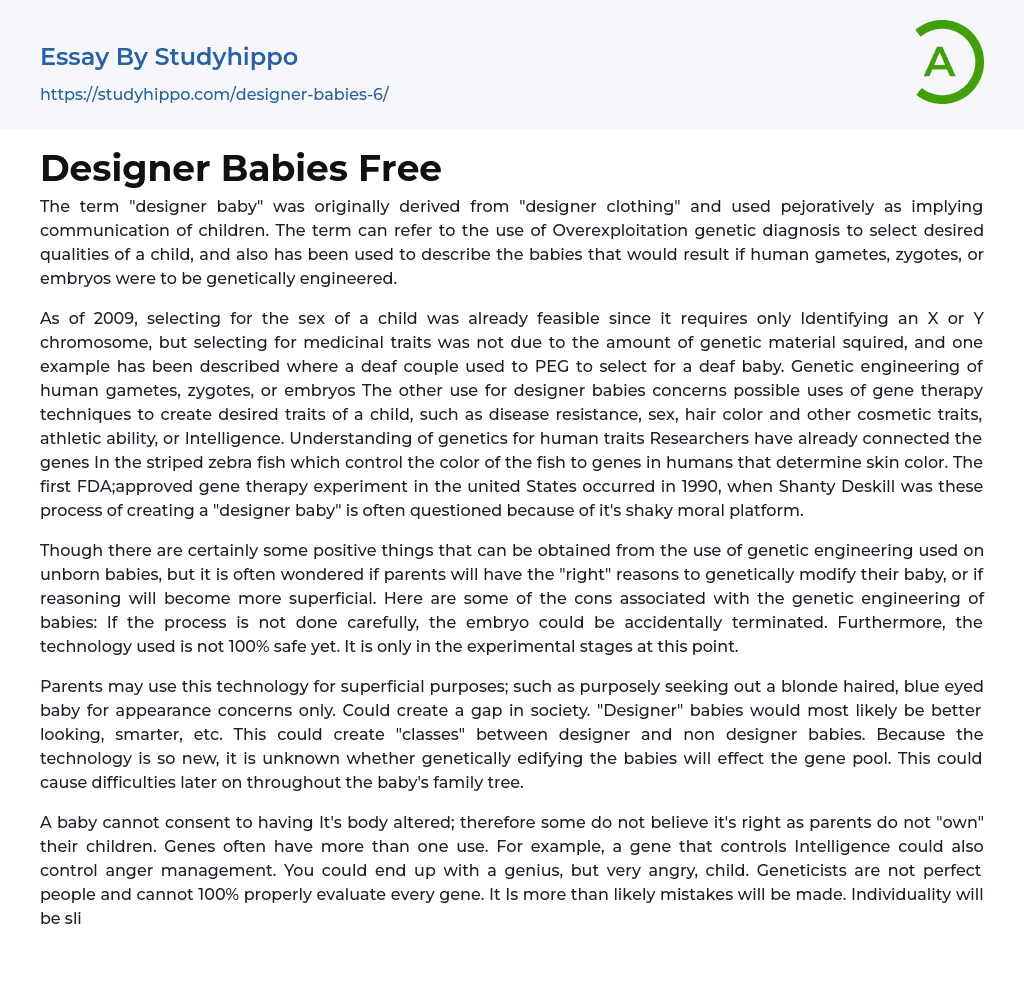The term "designer baby" was coined to compare it to "designer clothing," and it refers to the manipulation of children, which can involve genetic diagnosis for selecting desired qualities or engineering human gametes, zygotes, or embryos. While choosing a child's sex became possible by 2009, selecting medicinal traits faced challenges due to the need for significant amounts of genetic material. An example was given where a deaf couple utilized PEG in order to choose a deaf baby. This concept also includes using gene therapy techniques to determine traits such as disease resistance, sex, hair color, cosmetic attributes, athletic ability, or intelligence.
There has been research that links genes in fish and humans. The first FDA-approved gene therapy experiment occurred in the United States in 1990. However, there is an ongoing debate about the ethical implications of creating designer babies a
...s concerns arise regarding parents' intentions when modifying their baby. It remains uncertain whether parents will have valid reasons or if their motives will be purely superficial. One drawback is the possibility of accidental termination of embryos if not done carefully.In addition, it should be noted that this technology is still in the experimental stage and not completely safe. Parents may choose to utilize this technology for superficial purposes, such as selecting specific appearance traits like blonde hair and blue eyes. However, this has the potential to create societal division, where a distinction emerges between designer babies and non-designer babies who are perceived as more attractive or intelligent. The long-term consequences on the gene pool remain uncertain due to the newness of genetic editing.
There is also a moral dilemma regarding altering a baby's body without their consen
since parents do not have ownership over their children. Genes often serve multiple purposes; for example, a gene that influences intelligence can also impact anger management. Therefore, it is possible to have an exceptionally intelligent but irritable child.
Furthermore, geneticists are fallible and cannot accurately assess every gene with absolute certainty. Errors are likely to occur during the process, which could lead society to disregard individuality in favor of good-looking and intelligent babies with other desirable traits.
Additionally, the procedure itself is expensive and not accessible to everyone. This has the potential to foster prejudice between "Designer" and "non-designer" children, potentially resulting in missed opportunities for the latter in areas like employment.Genetically modifying babies, despite ethical concerns, offers numerous benefits such as advancing our understanding of genetics, extending human lifespan by up to 30 years, preventing genetic diseases and reducing the likelihood of inherited medical conditions. It is important to acknowledge that genetically engineering babies is not obligatory for all parents; rather it represents a choice made to ensure their child's well-being. Parents have the ability to shape their children's lives through various means including prenatal supplements, education, religion, and morals. One ethically acceptable medical intervention involves taking folate during pregnancy to decrease the risk of autism in a child while also eliminating mitochondrial disorders. Thus, parents should be allowed to establish their own boundaries regarding genetic engineering for their baby. However, implementing a complete ban on these practices may lead to an increase in unauthorized biologists or individuals seeking treatment abroad even though the US has similar capabilities. Some argue that instead of government control over reproductive methods, preventive measures should be implemented for unavoidable environmental
factors. Genetic technology enables prospective parents to provide their child with genes they do not possess themselves.Acknowledging the potential ethical concerns that may accompany scientific and technological advancements, it is crucial not to impede progress in this domain. Despite remaining unresolved matters, conducting additional clinical trials and experiments offers promising prospects for success in this field of technology.
- Baby Clothes essays
- Microbiology essays
- Bacteria essays
- Cell essays
- Enzyme essays
- Photosynthesis essays
- Plant essays
- Natural Selection essays
- Protein essays
- Viruses essays
- Cell Membrane essays
- Human essays
- Stem Cell essays
- Breeding essays
- Biotechnology essays
- Cystic Fibrosis essays
- Tree essays
- Seed essays
- Coronavirus essays
- Zika Virus essays
- Dna essays
- Gene essays
- Anatomy and Physiology essays
- Addiction essays
- Biodegradation essays
- Dental Care essays
- Disease essays
- Disorders essays
- Health Care essays
- Intelligence Quotient essays
- Nutrition essays
- Olfaction essays
- Public Health essays
- Women's Health essays
- World health organization essays
- Cancer essays
- Infectious Disease essays
- Lung Cancer essays
- Neurology essays
- Physical Exercise essays
- Medicine essays
- Sex essays
- Inquiry essays
- Disability essays
- Poison essays
- Action Potential essays
- Nervous System essays
- Childbirth essays
- Puberty essays
- Blood essays




